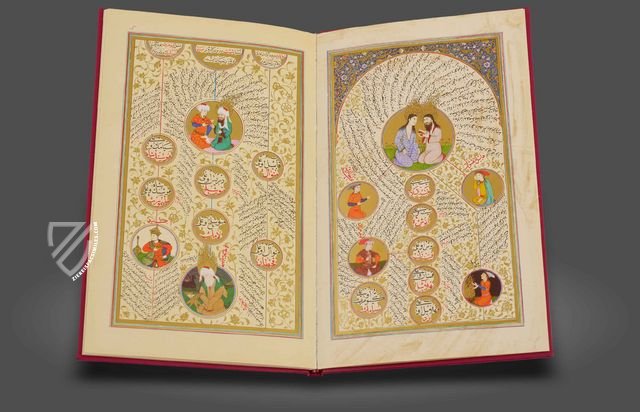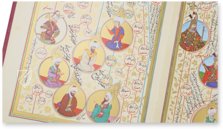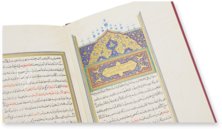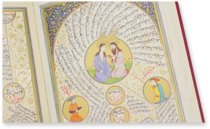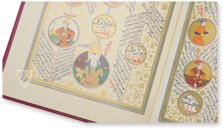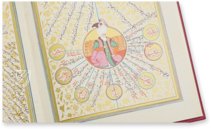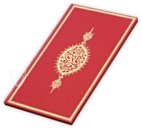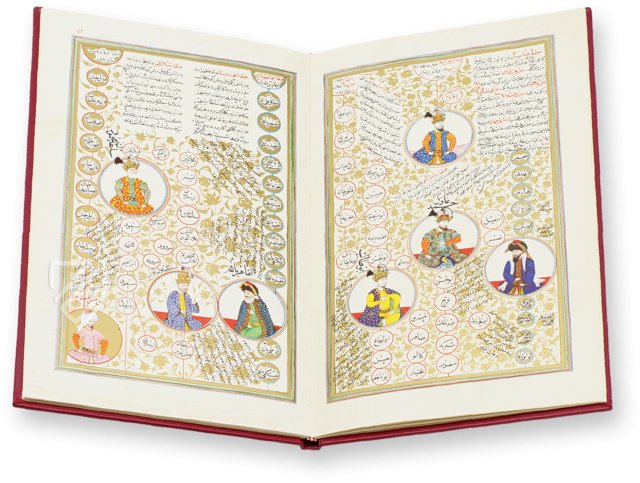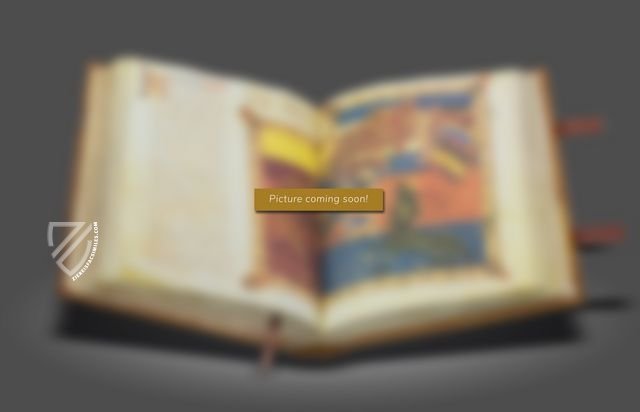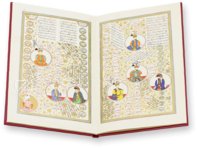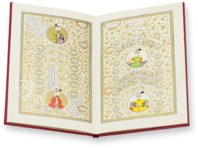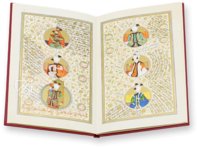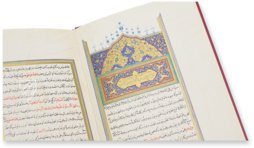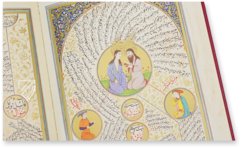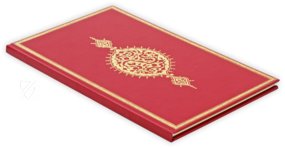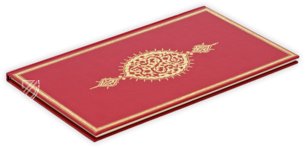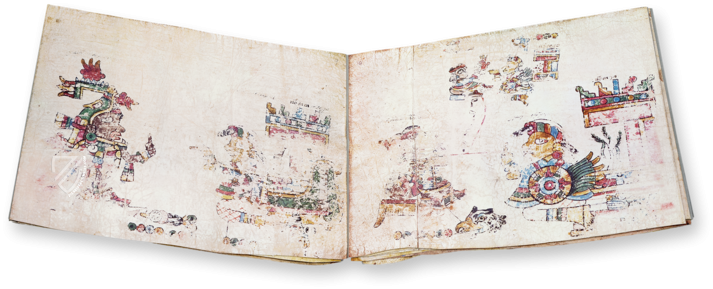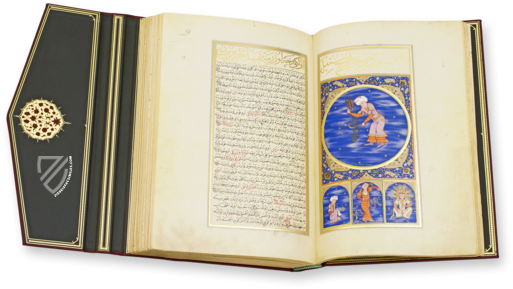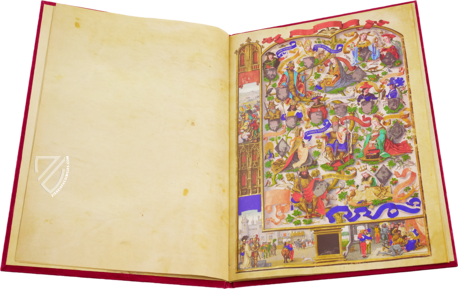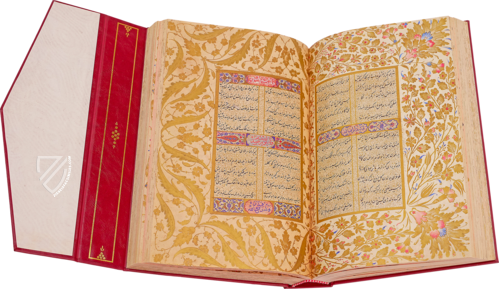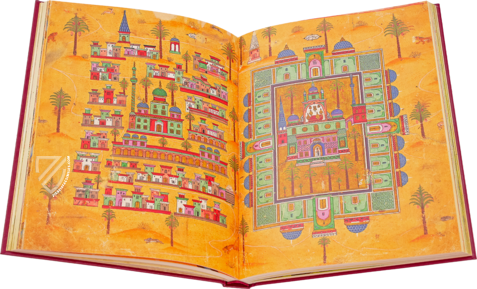Rosary of World History - Subḥat al-aḫbār
(under 1,000€)
This splendid genealogical manuscript traces the origins of the Ottoman dynasty through the centuries and all the way back to Adam and Eve. The so-called Rosary of World History is a genealogical work of the highest artistic quality and is one of the finest specimens of this genre of Ottoman illumination. It is also an unusual manuscript for this genre because was created as a codex rather than a scroll. Masterfully designed portraits created with a splendid color palette and gold leaf are accompanied by short biographical texts originally written during the 16th century and appended until the late-17th century, when this manuscript was made by a team of highly skilled and experienced artists. This team combined Western and Eastern artistic influences with an incredible color palette and generously applied gold leaf to create this masterpiece.
Rosary of World History
Illuminated family trees like this were created throughout the Ottoman Empire and were often owned by state functionaries. Although these family trees offer little in the way of new insights for historians, they are nonetheless of great art-historical worth. Vienna is home to one of the finest manuscripts to artfully depict the family tree of the Ottoman dynasty, which is called Subḥat al-aḫbār or “Rosary of World History”.
Such works are typically found recorded on long paper scrolls, whereby the character of the family tree stands out all the more clearly, but this manuscript takes the form of a more functional codex. Nonetheless, the geometric scheme is maintained in book form, and the connecting red lines were stretched to the margins of the pages in order that they build a sequence from page to page.
The text was written by Mahmud ibn Shaik Ramadan and is based on the anonymous work Züb detü t-Tevārīḫ or “Quintessence of Histories” from the reign of Suleiman the Magnificent in the 16th century. It was appended in the years to follow and this manuscript was created during the latter period of Sultan Meḥmed IV’s reign (r. 1648–1687).
A Magnificent Imperial Genealogy
The genealogy begins with Adam and Eve and includes their children, prophets of the Old Testament, portraits of Persian rulers, Alexander the Great, John the Baptist, Jesus Christ, Mohammed and the caliphs who followed him, and other important religious figures. This bloodline continues through the most important emirs and caliphs of the Islamic Middle Ages, then Turkish princes, members of later Persian dynasties, the Mongols and Timurids, before finishing with the six Ottoman Sultans who had ruled up to the time when the manuscript was made.
The Sultans appear in portraits while family members are depicted in medallion miniatures, often with gold leaf backgrounds, each with a short biography neatly written in Naskh script written in black and red ink. Artistic influences are evident from both Europe, especially the throne depictions, and Asia with regard to the ornamental perspective. These influences were seamlessly integrated and designed with a splendid color palette and soft shapes by a skilled team of experienced artists, making this a true masterpiece of 17th century Ottoman illumination.
Codicology
- Alternative Titles
- Rosary of World History
Rosenkranz der Weltgeschichte
Subḥat al-aḫbār
Genealogy of Suleiman the Magnificent
Biblia Otomana - Size / Format
- 34 pages / 30.0 × 18.5 cm
- Origin
- Turkey
- Date
- 17th century
- Epochs
- Style
- Language
- Illustrations
- 102 gold-decorated medallion miniatures in bold colors and gold ornaments throughout the codex
Rosary of World History - Subḥat al-aḫbār
Introduction
The introduction page has a decorative header that is as splendid and detailed as any of the miniatures that follow. It is an exemplary specimen of Islamic art and has the title written against a gold leaf background on a carpet, a popular decorative element in Muslim manuscripts that also appeared in Christian art, Insular manuscripts in particular. The deep blue background contrasts wonderfully with the winding golden tendrils, which are filled with colorful blooming flowers.

Rosary of World History - Subḥat al-aḫbār
Orhan, Murad I, Bayezid I, and Mehmed I
After tracing their line back to early Muslim rulers, Persian dynasties, historic figures like Alexander the Great, and biblical figures ranging from Adam and Eve to Jesus Christ, the manuscript depicts the actual line of descent of the Ottoman’s ruling house. Four beys (chieftains) and sultans are presented here in glimmering golden medallions with golden flowers.
These four monarchs ruled over the Ottoman Turks from 1323 to 1421, a century during which time they established themselves as the most powerful force in the Middle East. They are all shown sitting cross legged and leaning up against large cushions. Each is dressed in a turban with flowing brocade robes and Bayezid I, who built one of the world’s largest armies, holds a sword.

#1 Der Rosenkranz der Weltgeschichte
Language: German
(under 1,000€)
#2 Biblia Otomana (Subhat-al-ahbar)
Language: Spanish
(1,000€ - 3,000€)
- Treatises / Secular Books
- Apocalypses / Beatus
- Astronomy / Astrology
- Bestiaries
- Bibles / Gospels
- Chronicles / History / Law
- Geography / Maps
- Saints' Lives
- Islam / Oriental
- Judaism / Hebrew
- Single Leaf Collections
- Leonardo da Vinci
- Literature / Poetry
- Liturgical Manuscripts
- Medicine / Botany / Alchemy
- Music
- Mythology / Prophecies
- Psalters
- Other Religious Books
- Games / Hunting
- Private Devotion Books
- Other Genres
- Afghanistan
- Armenia
- Austria
- Belgium
- Colombia
- Croatia
- Cyprus
- Czech Republic
- Denmark
- Egypt
- Ethiopia
- France
- Germany
- Greece
- Hungary
- India
- Iran
- Iraq
- Israel
- Italy
- Japan
- Lebanon
- Luxembourg
- Mexico
- Morocco
- Netherlands
- Palestine
- Peru
- Poland
- Portugal
- Russia
- Serbia
- Spain
- Sri Lanka
- Sweden
- Switzerland
- Syria
- Turkey
- Ukraine
- United Kingdom
- United States
- Uzbekistan
- Aboca Museum
- Ajuntament de Valencia
- Akademie Verlag
- Akademische Druck- u. Verlagsanstalt (ADEVA)
- Aldo Ausilio Editore - Bottega d’Erasmo
- Alecto Historical Editions
- Alkuin Verlag
- Almqvist & Wiksell
- Amilcare Pizzi
- Andreas & Andreas Verlagsbuchhandlung
- Archa 90
- Archiv Verlag
- Archivi Edizioni
- Arnold Verlag
- ARS
- Ars Magna
- ArtCodex
- AyN Ediciones
- Azimuth Editions
- Badenia Verlag
- Bärenreiter-Verlag
- Belser Verlag
- Belser Verlag / WK Wertkontor
- Benziger Verlag
- Bernardinum Wydawnictwo
- BiblioGemma
- Biblioteca Apostolica Vaticana (Vaticanstadt, Vaticanstadt)
- Bibliotheca Palatina Faksimile Verlag
- Bibliotheca Rara
- Boydell & Brewer
- Bramante Edizioni
- Bredius Genootschap
- Brepols Publishers
- British Library
- C. Weckesser
- Caixa Catalunya
- Canesi
- CAPSA, Ars Scriptoria
- Caratzas Brothers, Publishers
- Carus Verlag
- Casamassima Libri
- Chavane Verlag
- Christian Brandstätter Verlag
- Circulo Cientifico
- Club Bibliófilo Versol
- Club du Livre
- CM Editores
- Collegium Graphicum
- Collezione Apocrifa Da Vinci
- Comissão Nacional para as Comemorações dos Descobrimentos Portugueses
- Coron Verlag
- Corvina
- CTHS
- D. S. Brewer
- Damon
- De Agostini/UTET
- De Nederlandsche Boekhandel
- De Schutter
- Deuschle & Stemmle
- Deutscher Verlag für Kunstwissenschaft
- DIAMM
- Droz
- E. Schreiber Graphische Kunstanstalten
- Ediciones Boreal
- Ediciones Grial
- Ediclube
- Edições Inapa
- Edilan
- Editalia
- Edition Deuschle
- Edition Georg Popp
- Edition Leipzig
- Edition Libri Illustri
- Editiones Reales Sitios S. L.
- Éditions de l'Oiseau Lyre
- Editions Medicina Rara
- Editorial Casariego
- Editorial Mintzoa
- Editrice Antenore
- Editrice Velar
- Edizioni Edison
- Egeria, S.L.
- Eikon Editores
- Electa
- Emery Walker Limited
- Enciclopèdia Catalana
- Eos-Verlag
- Ephesus Publishing
- Ernst Battenberg
- Eugrammia Press
- Extraordinary Editions
- Fackelverlag
- Facsimila Art & Edition
- Facsimile Editions Ltd.
- Facsimilia Art & Edition Ebert KG
- Faksimile Verlag
- Feuermann Verlag
- Folger Shakespeare Library
- Franco Cosimo Panini Editore
- Friedrich Wittig Verlag
- Fundación Hullera Vasco-Leonesa
- G. Braziller
- Gabriele Mazzotta Editore
- Gebr. Mann Verlag
- Gesellschaft für graphische Industrie
- Getty Research Institute
- Giovanni Domenico de Rossi
- Giunti Editore
- Graffiti
- Grafica European Center of Fine Arts
- Guido Pressler
- Guillermo Blazquez
- Gustav Kiepenheuer
- H. N. Abrams
- Harrassowitz
- Helikon
- Hendrickson Publishers
- Henning Oppermann
- Herder Verlag
- Hes & De Graaf Publishers
- Hoepli
- Holbein-Verlag
- Hortus Deliciarum
- Houghton Library
- Hugo Schmidt Verlag
- Idion Verlag
- Il Bulino, edizioni d'arte
- ILte
- Imago
- Insel Verlag
- Instituto Nacional de Antropología e Historia
- Istituto dell'Enciclopedia Italiana - Treccani
- Istituto Ellenico di Studi Bizantini e Postbizantini
- Istituto Geografico De Agostini
- Istituto Poligrafico e Zecca dello Stato
- Italarte Art Establishments
- J. Thorbecke
- Jan Thorbecke Verlag
- Johnson Reprint Corporation
- Josef Stocker
- Josef Stocker-Schmid
- Jugoslavija
- Karl W. Hiersemann
- Kasper Straube
- Kaydeda Ediciones
- Kindler Verlag / Coron Verlag
- Kodansha International Ltd.
- Konrad Kölbl Verlag
- Kurt Wolff Verlag
- La Liberia dello Stato
- La Linea Editrice
- La Meta Editore
- Lambert Schneider
- Landeskreditbank Baden-Württemberg
- Leo S. Olschki
- Les Incunables
- Library of Congress
- Libreria Musicale Italiana
- Lichtdruck
- Lito Immagine Editore
- Lumen Artis
- Lund Humphries
- M. Moleiro Editor
- Maison des Sciences de l'homme et de la société de Poitiers
- Manuscriptum
- Martinus Nijhoff
- Maruzen-Yushodo Co. Ltd.
- MASA
- McGraw-Hill
- Militos
- Millennium Liber
- Müller & Schindler
- Nahar and Steimatzky
- National Library of Wales
- Neri Pozza
- Nova Charta
- Oceanum Verlag
- Odeon
- Orbis Mediaevalis
- Orbis Pictus
- Österreichische Staatsdruckerei
- Oxford University Press
- Pageant Books
- Parzellers Buchverlag
- Patrimonio Ediciones
- Pattloch Verlag
- PIAF
- Pieper Verlag
- Plon-Nourrit et cie
- Prestel Verlag
- Princeton University Press
- Prisma Verlag
- Priuli & Verlucca, editori
- Pro Sport Verlag
- Propyläen Verlag
- Pytheas Books
- Quaternio Verlag Luzern
- Reales Sitios
- Recht-Verlag
- Reichert Verlag
- Reichsdruckerei
- Riehn & Reusch
- Roberto Vattori Editore
- Rosenkilde and Bagger
- Roxburghe Club
- Salerno Editrice
- Sarajevo Svjetlost
- Schöck ArtPrint Kft.
- Scolar Press
- Scrinium
- Scripta Maneant
- Scriptorium
- Siloé, arte y bibliofilia
- SISMEL - Edizioni del Galluzzo
- Sociedad Mexicana de Antropología
- Société des Bibliophiles & Iconophiles de Belgique
- Soncin Publishing
- Sorli Ediciones
- Stainer and Bell
- Studer
- Styria Verlag
- Sumptibus Pragopress
- Szegedi Tudomànyegyetem
- Taberna Libraria
- Tarshish Books
- Taschen
- Tempus Libri
- Testimonio Compañía Editorial
- Thames and Hudson
- The Clear Vue Publishing Partnership Limited
- The Facsimile Codex
- The Folio Society
- The Marquess of Normanby
- The Richard III and Yorkist History Trust
- Tip.Le.Co
- TouchArt
- TREC Publishing House
- TRI Publishing Co.
- Trident Editore
- Typis Regiae Officinae Polygraphicae
- Union Verlag Berlin
- Universidad de Granada
- University of California Press
- University of Chicago Press
- Urs Graf
- Vallecchi
- Van Wijnen
- VCH, Acta Humaniora
- VDI Verlag
- VEB Deutscher Verlag für Musik
- Verlag Anton Pustet / Andreas Verlag
- Verlag Bibliophile Drucke Josef Stocker
- Verlag der Münchner Drucke
- Verlag für Regionalgeschichte
- Verlag Styria
- Vicent Garcia Editores
- W. Turnowsky
- Waanders Printers
- Wiener Mechitharisten-Congregation (Wien, Österreich)
- Wissenschaftliche Buchgesellschaft
- Wydawnictwo Dolnoslaskie
- Xuntanza Editorial
- Zakład Narodowy
- Zollikofer AG

